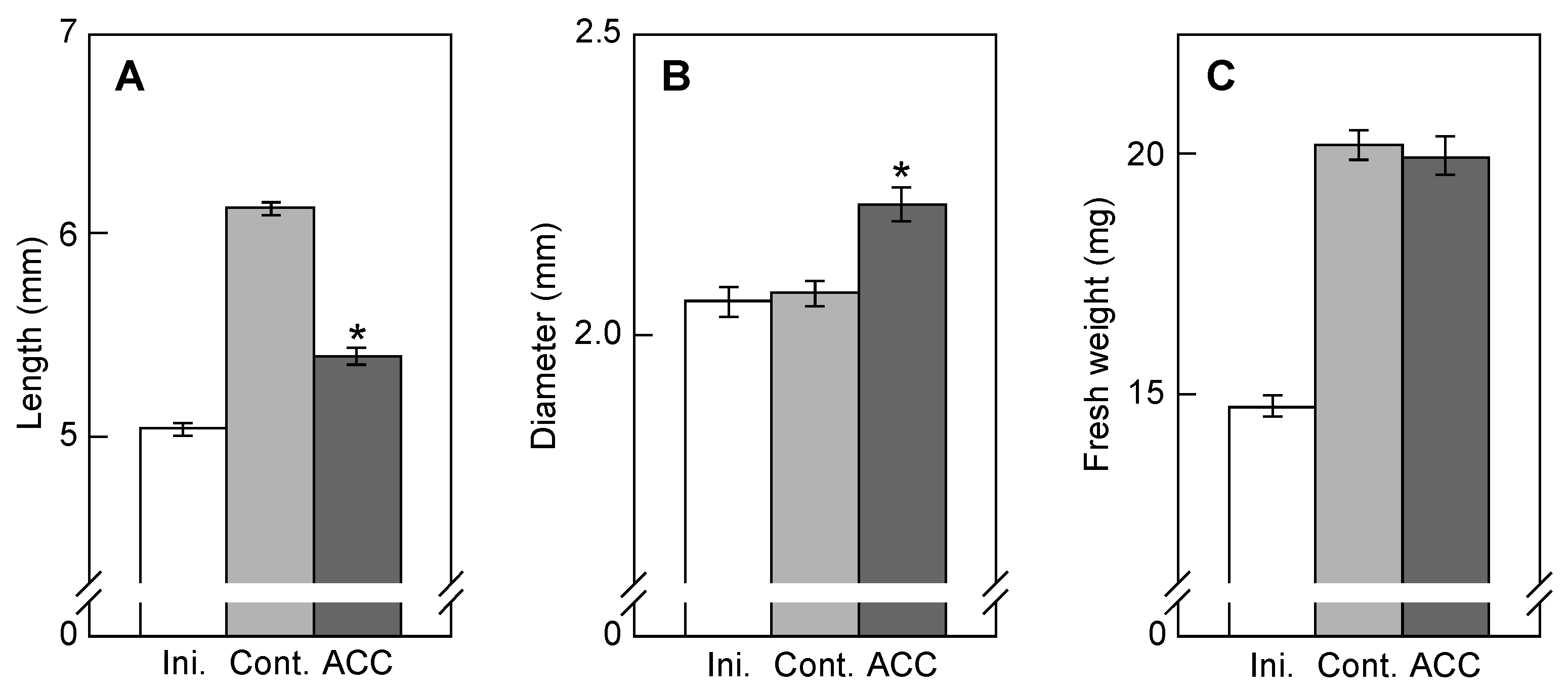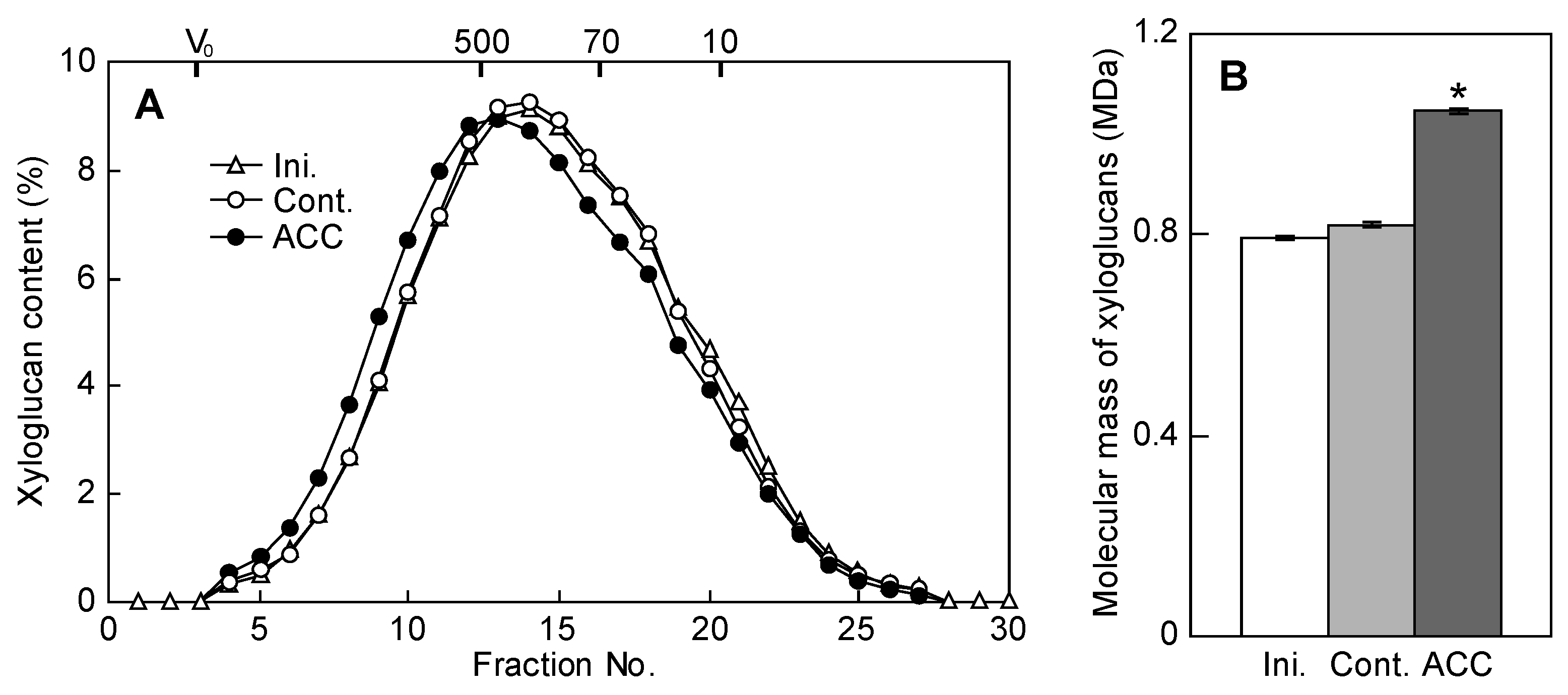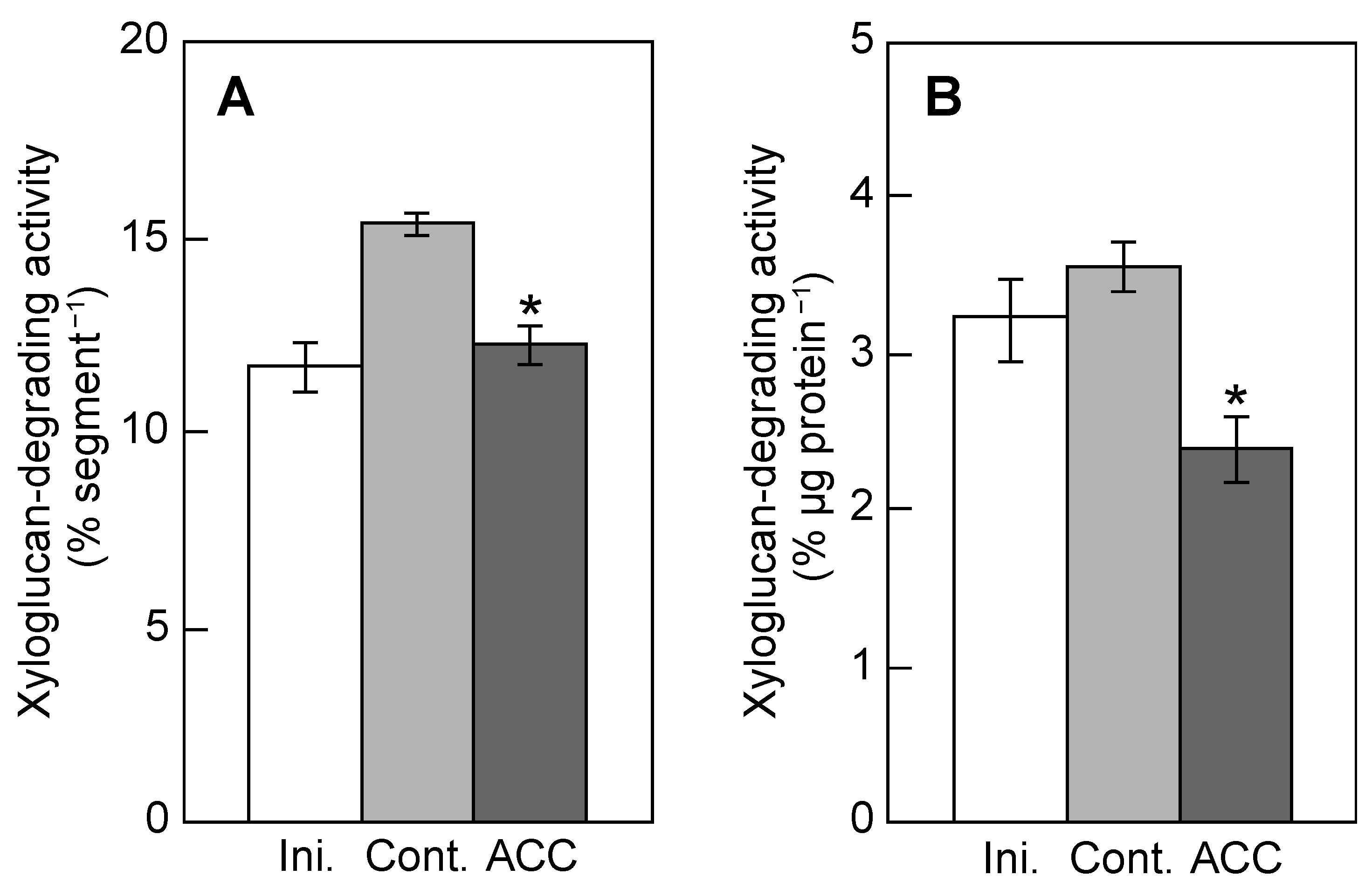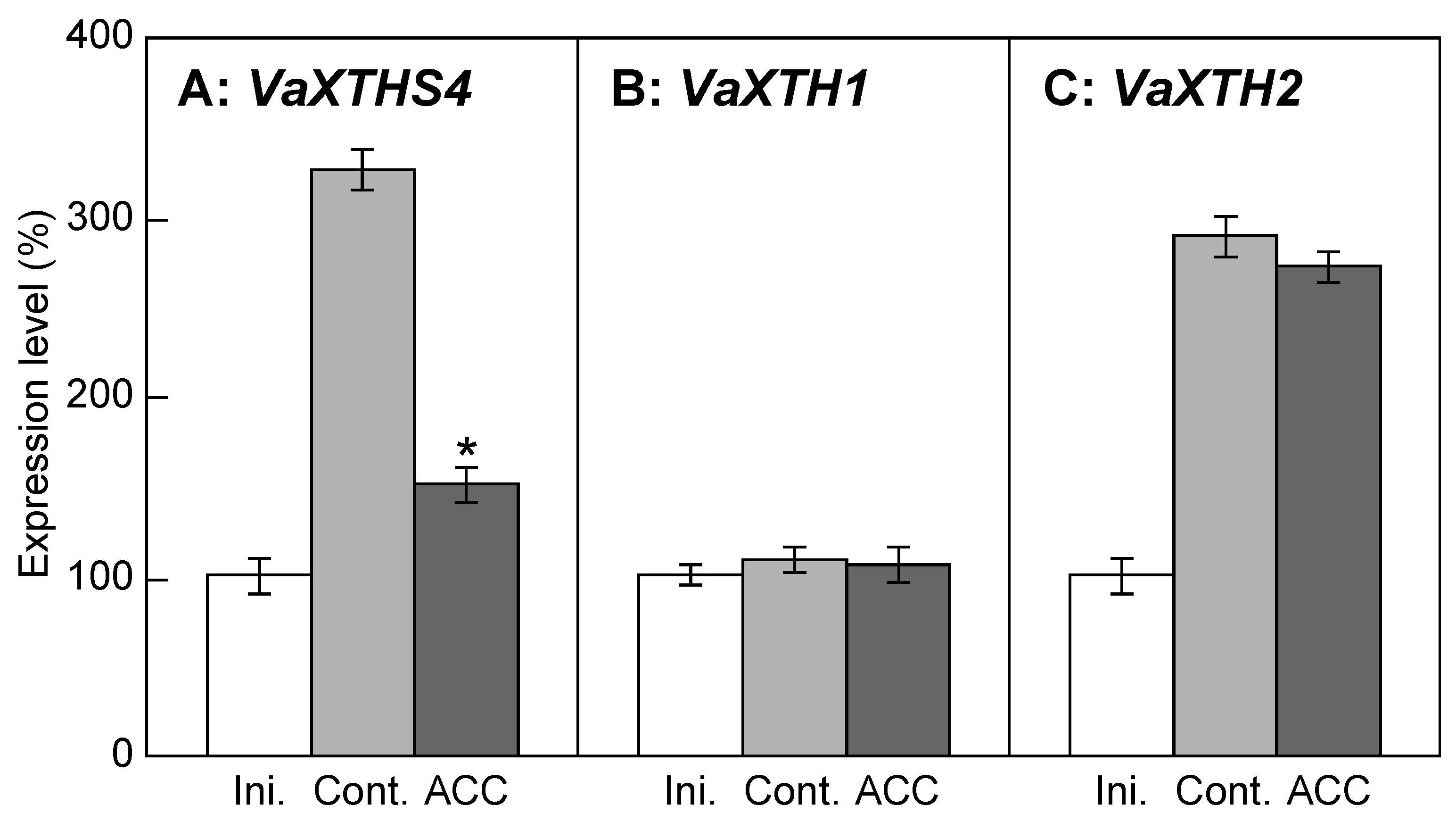Modification of Xyloglucan Metabolism during a Decrease in Cell Wall Extensibility in 1-Aminocyclopropane-1-Carboxylic Acid-Treated Azuki Bean Epicotyls
Abstract
1. Introduction
2. Results
2.1. Growth and Extensibility of Cell Walls
2.2. Molecular Mass of Xyloglucans
2.3. Activity of Xyloglucan-Degrading Enzymes and XTH Expression
3. Discussion
4. Materials and Methods
4.1. Plant Materials and Growth Experiments
4.2. Cell Wall Extensibility
4.3. Molecular Mass of Xyloglucans
4.4. Xyloglucan-Degrading Activity
4.5. Gene Expression of XTHs
4.6. Statistical Analysis
5. Conclusions
Author Contributions
Funding
Data Availability Statement
Conflicts of Interest
References
- Bakshi, A.; Shemansky, J.M.; Chang, C.; Binder, B.M. History of research on the plant hormone ethylene. J. Plant Growth Regul. 2015, 34, 809–827. [Google Scholar] [CrossRef]
- Wei, H.; Xue, Y.; Chen, P.; Hao, P.; Wei, F.; Sun, L.; Yang, Y. Genome-wide identification and functional investigation of 1-aminocyclopropane-1-carboxylic acid oxidase (ACO) genes in cotton. Plants 2021, 10, 1699. [Google Scholar] [CrossRef] [PubMed]
- Qiu, D.; Xu, S.; Wang, Y.; Zhou, M.; Hong, L. Primary cell wall modifying proteins regulate wall mechanics to steer plant morphogenesis. Front. Plant Sci. 2021, 12, 751372. [Google Scholar] [CrossRef]
- Ridge, I. The control of cell shape and rate of cell expansion by ethylene: Effects on microfibril orientation and cell wall extensibility in etiolated peas. Acta Bot. Neerl. 1973, 22, 144–158. [Google Scholar] [CrossRef]
- Wu, Q.; Li, Y.; Lyu, M.; Luo, Y.; Shi, H.; Zhong, S. Touch-induced seedling morphological changes are determined by ethylene-regulated pectin degradation. Sci. Adv. 2020, 6, eabc9294. [Google Scholar] [CrossRef]
- Park, Y.B.; Cosgrove, D.J. Xyloglucan and its interactions with other components of the growing cell wall. Plant Cell Physiol. 2015, 56, 180–194. [Google Scholar] [CrossRef]
- Nishitani, K.; Masuda, Y. Auxin-induced changes in the cell wall structure: Changes in the sugar composition, intrinsic viscosity and molecular weight distributions of matrix polysaccharides of the epicotyl cell wall of Vigna angularis. Physiol. Plant. 1981, 52, 482–494. [Google Scholar] [CrossRef]
- Miyamoto, K.; Mitani, Y.; Soga, K.; Ueda, J.; Wakabayashi, K.; Hoson, T.; Kamisaka, S.; Masuda, Y. Modification of chemical properties of cell wall polysaccharides in the inner tissues by white light in relation to the decrease in tissue tension in Pisum sativum epicotyls. Physiol. Plant. 1997, 101, 38–44. [Google Scholar] [CrossRef]
- Soga, K.; Wakabayashi, K.; Hoson, T.; Kamisaka, S. Hypergravity increases the molecular mass of xyloglucans by decreasing xyloglucan-degrading activity in azuki bean epicotyls. Plant Cell Physiol. 1999, 40, 581–585. [Google Scholar] [CrossRef]
- Shinohara, N.; Nishitani, K. Cryogenian origin and subsequent diversification of the plant cell-wall enzyme XTH family. Plant Cell Physiol. 2021, 62, 1874–1889. [Google Scholar] [CrossRef]
- Ishida, K.; Yokoyama, R. Reconsidering the function of the xyloglucan endotransglucosylase/hydrolase family. J. Plant Res. 2022, 135, 145–156. [Google Scholar] [CrossRef] [PubMed]
- Nakamura, T.; Yokoyama, R.; Tomita, E.; Nishitani, K. Two azuki bean XTH genes, VaXTH1 and VaXTH2, with similar tissue-specific expression profiles, are differently regulated by auxin. Plant Cell Physiol. 2003, 44, 16–24. [Google Scholar] [CrossRef] [PubMed]
- Tabuchi, A.; Mori, H.; Kamisaka, S.; Hoson, T. A new type of endo-xyloglucan transferase devoted to xyloglucan hydrolysis in the cell wall of azuki bean epicotyls. Plant Cell Physiol. 2001, 42, 154–161. [Google Scholar] [CrossRef]
- Soga, K.; Wakabayashi, K.; Kamisaka, S.; Hoson, T. Effects of hypergravity on expression of XTH genes in azuki bean epicotyls. Physiol. Plant. 2007, 131, 332–340. [Google Scholar] [CrossRef]
- Maurice, E.T.; Bernard, R.; Russell, L.J. Soluble cell wall polysaccharides released from pea stems by centrifugation: II. Effect of ethylene. Plant Physiol. 1981, 68, 538–542. [Google Scholar]
- Chen, H.; Bullock, D.A., Jr.; Alonso, J.M.; Stepanova, A.N. To fight or to grow: The balancing role of ethylene in plant abiotic stress responses. Plants 2022, 11, 33. [Google Scholar] [CrossRef]
- Soga, K.; Yamaguchi, A.; Kotake, T.; Wakabayashi, K.; Hoson, T. 1-Aminocyclopropane-1-carboxylic acid (ACC)-induced reorientation of cortical microtubules is accompanied by a transient increase in the transcript levels of γ-tubulin complex and katanin genes in azuki bean epicotyls. J. Plant Physiol. 2010, 167, 1165–1171. [Google Scholar] [CrossRef] [PubMed]
- Stimpson, T.C.; Cathala, B.; Moreau, C.; Moran-Mirabal, J.M.; Cranston, E.D. Xyloglucan structure impacts the mechanical properties of xyloglucan-cellulose nanocrystal layered films—A buckling-based study. Biomacromolecules 2020, 21, 3898–3908. [Google Scholar] [CrossRef]
- Soga, K.; Wakabayashi, K.; Kamisaka, S.; Hoson, T. Stimulation of elongation growth and xyloglucan breakdown in Arabidopsis hypocotyls under microgravity conditions in space. Planta 2002, 215, 1040–1046. [Google Scholar] [CrossRef]
- Kaku, T.; Tabuchi, A.; Wakabayashi, K.; Kamisaka, S.; Hoson, T. Action of xyloglucan hydrolase within the native cell wall architecture and its effect on cell wall extensibility in azuki bean epicotyls. Plant Cell Physiol. 2002, 43, 21–26. [Google Scholar] [CrossRef]
- Markakis, M.N.; De Cnodder, T.; Lewandowski, M.; Simon, D.; Boron, A.; Balcerowicz, D.; Doubbo, T.; Taconnat, L.; Renou, J.P.; Höfte, H.; et al. Identification of genes involved in the ACC-mediated control of root cell elongation in Arabidopsis thaliana. BMC Plant Biol. 2021, 12, 208. [Google Scholar] [CrossRef] [PubMed]
- Yokoyama, R.; Nishitani, K. A comprehensive expression analysis of all members of a gene family encoding cell-wall enzymes allowed us to predict cis-regulatory regions involved in cell-wall construction in specific organs of Arabidopsis. Plant Cell Physiol. 2001, 42, 1025–1033. [Google Scholar] [CrossRef] [PubMed]
- Miedes, E.; Suslov, D.; Vandenbussche, F.; Kenobi, K.; Ivakov, A.; Van Der Straeten, D.; Lorences, E.P.; Mellerowicz, E.J.; Verbelen, J.P.; Vissenberg, K. Xyloglucan endotransglucosylase/hydrolase (XTH) overexpression affects growth and cell wall mechanics in etiolated Arabidopsis hypocotyls. J. Exp. Bot. 2013, 64, 2481–2497. [Google Scholar] [CrossRef] [PubMed]
- Wang, M.; Xu, Z.; Ding, A.; Kong, Y. Genome-wide identification and expression profiling analysis of the xyloglucan endotransglucosylase/hydrolase gene family in taobacco (Nicotiana tabacum L.). Genes 2018, 9, 273. [Google Scholar] [CrossRef]
- Polko, J.K.; van Zanten, M.; van Rooij, J.A.; Marée, A.F.; Voesenek, L.A.; Peeters, A.J.; Pierik, R. Ethylene-induced differential petiole growth in Arabidopsis thaliana involves local microtubule reorientation and cell expansion. New Phytol. 2012, 193, 339–348. [Google Scholar] [CrossRef]
- Soga, K.; Kotake, T.; Wakabayashi, K.; Hoson, T. Changes in the transcript levels of microtubule-associated protein MAP65-1 during reorientation of cortical microtubules in azuki bean epicotyls. Acta Physiol. Plant. 2012, 34, 533–540. [Google Scholar] [CrossRef]
- Ma, Q.; Sun, J.; Mao, T. Microtubule bundling plays a role in ethylene-mediated cortical microtubule reorientation in etiolated Arabidopsis hypocotyls. J. Cell Sci. 2016, 129, 2043–2051. [Google Scholar]





| Factor | Elongation Growth | Cell Wall Extensibility | Molecular Mass of Xyloglucans | Reference |
|---|---|---|---|---|
| ACC (ethylene) | Inhibition | Decrease | Increase | This study |
| Auxin | Promotion | Increase | Decrease | [7] |
| Light | Inhibition | Decrease | Increase | [8] |
| Microgravity | Promotion | Increase | Decrease | [19] |
| Hypergravity | Inhibition | Decrease | Increase | [9] |
Disclaimer/Publisher’s Note: The statements, opinions and data contained in all publications are solely those of the individual author(s) and contributor(s) and not of MDPI and/or the editor(s). MDPI and/or the editor(s) disclaim responsibility for any injury to people or property resulting from any ideas, methods, instructions or products referred to in the content. |
© 2023 by the authors. Licensee MDPI, Basel, Switzerland. This article is an open access article distributed under the terms and conditions of the Creative Commons Attribution (CC BY) license (https://creativecommons.org/licenses/by/4.0/).
Share and Cite
Yamaguchi, A.; Soga, K.; Wakabayashi, K.; Hoson, T. Modification of Xyloglucan Metabolism during a Decrease in Cell Wall Extensibility in 1-Aminocyclopropane-1-Carboxylic Acid-Treated Azuki Bean Epicotyls. Plants 2023, 12, 367. https://doi.org/10.3390/plants12020367
Yamaguchi A, Soga K, Wakabayashi K, Hoson T. Modification of Xyloglucan Metabolism during a Decrease in Cell Wall Extensibility in 1-Aminocyclopropane-1-Carboxylic Acid-Treated Azuki Bean Epicotyls. Plants. 2023; 12(2):367. https://doi.org/10.3390/plants12020367
Chicago/Turabian StyleYamaguchi, Aya, Kouichi Soga, Kazuyuki Wakabayashi, and Takayuki Hoson. 2023. "Modification of Xyloglucan Metabolism during a Decrease in Cell Wall Extensibility in 1-Aminocyclopropane-1-Carboxylic Acid-Treated Azuki Bean Epicotyls" Plants 12, no. 2: 367. https://doi.org/10.3390/plants12020367
APA StyleYamaguchi, A., Soga, K., Wakabayashi, K., & Hoson, T. (2023). Modification of Xyloglucan Metabolism during a Decrease in Cell Wall Extensibility in 1-Aminocyclopropane-1-Carboxylic Acid-Treated Azuki Bean Epicotyls. Plants, 12(2), 367. https://doi.org/10.3390/plants12020367







